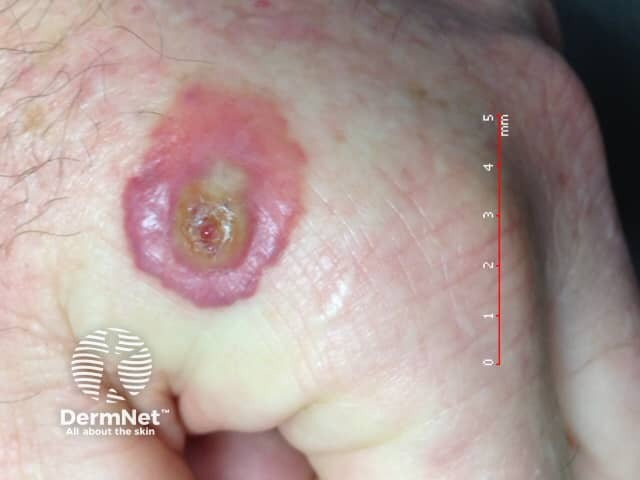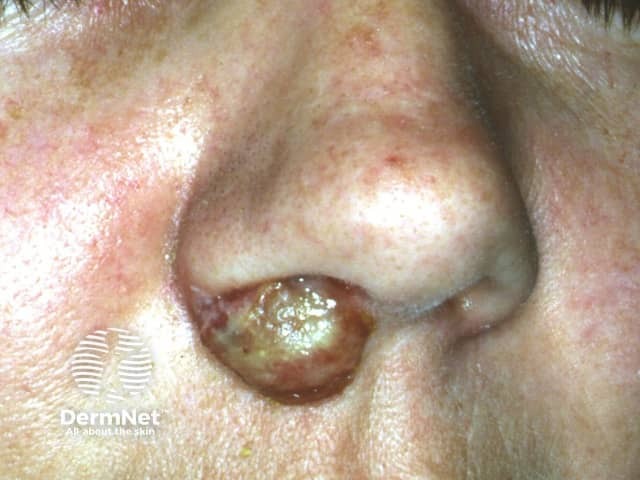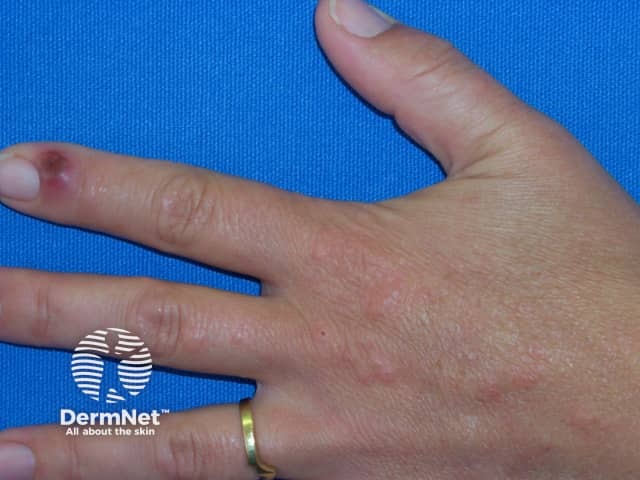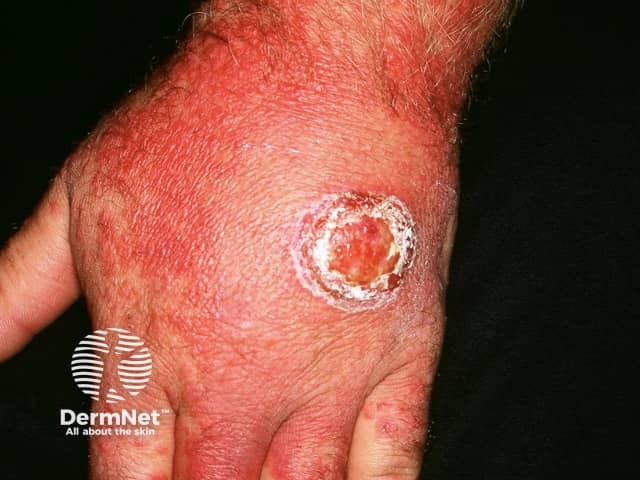Main menu
Common skin conditions

NEWS
Join DermNet PRO
Read more
Quick links
Orf — extra information
Orf
Author: Mark Duffill, Dermatologist, Hamilton, New Zealand, 2001. Updated by A/Prof Amanda Oakley, Dermatologist, Hamilton, New Zealand, November 2017.
Introduction
Orf in sheep and goats
Complications
Diagnosis
Treatment
Prevention
What is orf?
Orf is a zoonotic viral skin infection that is contracted from sheep and goats. It is caused by the parapox virus, a large DNA virus that replicates in cellular cytoplasm.
Orf in sheep and goats
Orf mainly infects young lambs and goats who contract the infection from one another or possibly from persistence of the virus in the pastures or sheds. The disease is called contagious pustular dermatitis or scabby mouth in the animal because it forms crusts and scabs around nose, mouth, teats and elsewhere. As it reduces suckling, the animal can lose weight. The disease lasts about six weeks. It is highly contagious, so several animals in the herd may be infected.
Who gets orf?
Human lesions are caused by direct inoculation of infected material, often through an existing scratch or cut.
Orf is a risk for sheep farmers, shearers, freezing workers, or anyone that bottle-feeds a lamb. Children may also acquire it from playing on infected pasture or in a sheep shed. Butchers, meat porters and housewives are sometimes infected from carcasses, especially sheep heads.
Human orf has been reported after accidental contact with orf virus vaccine intended for the animals.
It is not usually transmitted from human to human, although this has been rarely reported.
What are the clinical features of orf?
Orf lesions are generally solitary or few in number. They occur most commonly on the fingers, hands or forearms but can appear on the face.
After an incubation period of 5–6 days, a small, firm, red or reddish-blue lump enlarges to form a flat-topped, blood-tinged pustule or blister. The fully developed lesion is usually 2–3 cm in diameter but may be as large as 5 cm. Characteristically, although there appears to be pus under the white skin, incising this will reveal firm, red tissue underneath. The orf lesion is sometimes irritable during the early stages and is often tender.
Red streaks up the lymph channels (lymphangitis) with enlargement of the lymph glands on the inner side of the elbow and/or under the arm (lymphadenopathy) are not uncommon. There may be a mild fever.

Orf


What are the complications of orf?
Secondary bacterial infection can occur.
Patients who are immune deficient or immune suppressed may develop larger or unusual orf lesions. Rarely widespread small blisters may occur, suggesting blood stream spread of the orf virus, but resolve after a few weeks.
Erythema multiforme, a secondary rash to the presence of the orf virus, may develop 10–14 days after the onset of orf. It results in targetoid macules, plaques and blisters on the hands and feet, face, arms and legs. Less distinctive red rashes, 'toxic erythemas' also occur, and rarely the blistering disorder, pemphigoid.
Erythema multiforme associated with orf


Orf and EM

Orf and EM
How is orf diagnosed?
Orf is generally diagnosed clinically, in a person that has been handling sheep or goats.
The infection can be confirmed on a viral swab, skin biopsy or vesicular fluid by polymerase chain reaction (PCR). It can also be identified by electron microscopy.
A similar condition, caused by a related virus, occurs in dairy farmers and is called milkers' nodule.
Treatment of orf in humans
No specific treatment is necessary in most cases, as orf usually clears up by itself in about 6 weeks. The lesion should be covered to prevent contaminating the environment or other people, although person-to-person spread is very uncommon. Large lesions can be removed by shave excision.
Secondary bacterial infection should be treated with antibiotics.
Imiquimod cream has been reported to be effective in a few cases of orf.
Prevention of orf
Sheep and goat farmers should be aware of the possibility of orf and wear non-porous rubber gloves when handling the animals, particularly lambs and kids. Wash hands thoroughly or use an antiseptic gel to reduce the chance of infection.
Although people can develop multiple orf infections, some immunity to the virus is acquired after the first infection, so that it is less severe on subsequent occasions.
The disease can be minimised in sheep and goats by lower stocking rates and outdoor lambing. Vaccination of the herd using a live virus is recommended if there is a significant outbreak of orf. The vaccine causes a mild orf scab to develop at the vaccination site and should not be used in healthy herds where there is no history of orf. Vaccinated animals should be kept separate from unvaccinated animals until the scab has healed. Sheds should be thoroughly cleaned and disinfected.
On DermNet
Other websites
- Orf — Medscape Reference
- Orf virus in sheep — Farm Health Online.com
- Orf virus (sore mouth infection) — Centers for Disease Control and Prevention
